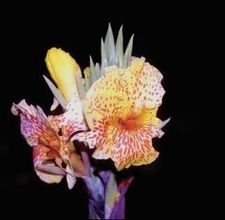 Canna (or Canna lily, although not a true lily) is a genus of nineteen species of flowering plants. The closest living relations to cannas are the other plant families of the order Zingiberales, that is the gingers, bananas, marantas, heliconias, strelitzias, etc. Canna (or Canna lily, although not a true lily) is a genus of nineteen species of flowering plants. The closest living relations to cannas are the other plant families of the order Zingiberales, that is the gingers, bananas, marantas, heliconias, strelitzias, etc.
Canna is the only genus in the family Cannaceae. Such a family has almost universally been recognized by taxonomists. The APG II system of 2003 (unchanged from the APG system, 1998) also recognizes the family, and assigns it to the order Zingiberales in the clade commelinids, in the monocots. The species have large, attractive foliage and horticulturists have turned it into a large-flowered and bright garden plant. In addition, it is one of the world's richest starch sources, and is an agricultural plant. Although a plant of the tropics, most cultivars have been developed in temperate climates and are easy to grow in most countries of the world as long as they can enjoy at least 6–8 hours average sunlight during the summer. See the Canna cultivar gallery for photographs of Canna cultivars. The name Canna originates from the Celtic word for a cane or reed.
Canna Lily grows like a Forb/herb. Canna Lily is an Perennial. Canna
Lily is Introduced to U.S.. Canna Lily has a National Wetland Indicator
Status of: OBL. Canna Lily is of the category, Monocot.
Popular as an exotic, tropical addition to borders and landscape designs for many years, the canna lily is grown from a rhizome and thrives in the warm summer season. Grown as a perennial in U.S. Department of Agriculture zones 8 and higher, the canna may also be displayed as a summer bulb accent in cooler weather climates and then dug up to be stored over winter. Available in a wide variety of spicy colors and interesting foliage, canna lilies are sure to provide that pop your landscape is lacking. | |||||
Types of Canna Lilies | |||||
| |||||
There are many popular flowers and the world. Most of flowers are very special and imported. flowers is not just beautiful to look at, but they serve a vital role to our ecosystems.Read the characteristic of different flowers in this blog and know how they are important.
____________________________________________________________________________________________________________________________________________________
____________________________________________________________________________________________________________________________________________________
Canna Lily
Subscribe to:
Post Comments (Atom)

No comments:
Post a Comment